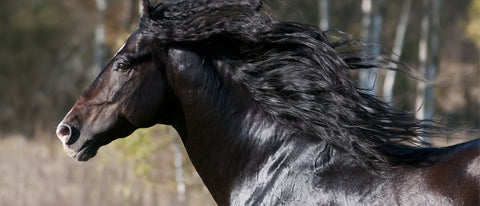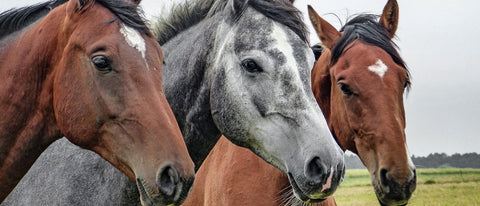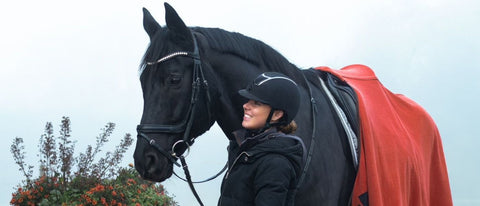
Florian ist aufgewachsen auf einem Bauernhof. Umgeben von Pferden, entdeckte er früh seine Faszination für diese majestätischen Tiere. Inspiriert von seiner reitbegeisterten Mutter, entwickelte er das Nahrungsergänzungmittel - Pferdegold. Seine tiefe Verbundenheit zur Natur und die leidenschaftliche Hingabe zu Pferden trieben ihn an, sein Unternehmen zu gründen.
Riding a horse can be a wonderful experience, but it requires careful preparation and consideration for safety. Follow traffic regulations and ensure good visibility to best protect yourself and your horse.
Gradually getting used to different environments is crucial – start with short distances and gradually increase them. A cautious approach will make road traffic a valuable training exercise, allowing you and your horse to ride out in a relaxed and safe manner.
When riding, rules for the safety of both must be observed
Adequate exercise and varied training are especially important. In addition to plenty of time on pasture, a ride in the countryside can also be beneficial. To ensure nothing goes wrong in the countryside or in traffic, you should follow a few rules when riding .
As a horse owner, you are responsible for your horse. To protect both of you and others, you should follow certain rules when riding.
Observe the road traffic regulations , be considerate of nature and your fellow human beings and follow the legal regulations for riding off- road and in traffic .
- When riding your horse, always use the roadway and not the sidewalk. Stay as far to the right of the road as possible.
- Be considerate of other road users and respect the right-of-way rules. Right-of-way and red lights also apply to horse riders!
- Never ride the wrong way down a one-way street.
- In poor light, you should ensure adequate lighting.
- A round sign with a horse and rider and a red border means that riding is prohibited on this path, but leading is permitted.
- A blue sign depicting a horse and rider indicates a bridleway. Use of this path is mandatory. You are not allowed to stray onto the road.
- The rules for riding on country roads and in forests can vary from state to state. Therefore, please check the regulations in your region.
Preparing horses for riding: Tips & hints
Before you go riding with your horse , you should make sure that you can really control it. It shouldn't be overly fearful.
- Practice riding with your horse in familiar surroundings. Practice stopping and backing up.
- To start with, you can also lead your horse and take him for a walk around the neighborhood. This will help you see which stimuli he reacts most sensitively to. It will also give him a chance to get used to new things.
- If you want to prepare horses for riding, don't venture miles away from the farm all at once. Start with small rounds and gradually increase the radius.
- Build familiarity by starting slowly with various exercises in the field. It may also be helpful to specifically practice transitions between gaits in the field.
- If necessary, calmness training for the horse may be useful.
- Put together equipment for your ride that suits you and your horse.
- Conduct a general health check and assess the condition of the hooves and coat. If you notice anything, you may need to consult your veterinarian. They can also tell you whether your horse is fit for a ride.
Pferdegold® supplementary feed!
A balanced diet is also essential for good general health . It also provides the energy needed for daily rides. Therefore, create a feeding plan that provides your horse with all the necessary vitamins and minerals, as well as the required energy.
If necessary, you can supplement the roughage and concentrate with a supplementary feed . You can purchase various supplementary feeds from Pferdegold . They contain carefully selected ingredients and can be easily mixed into the feed daily.

Perfect for your horse: Pferdegold® supplementary feed!
These specially developed supplements support your horse's diet and provide it with natural nutrients. Made in Germany, grain-free and drug-free, they come with a 30-day money-back guarantee.
Try it now!Tips for a successful ride
However, a good experience when riding a horse does not only depend on following various rules.
With the following tips, your ride will hopefully be a success:
- First, ask yourself this question: “Where can you ride horses?” and plan your route so that you spend as much time on field and forest paths and as little time as possible on busy roads.
- Also, check the weather forecast. A thunderstorm could scare your horse. Heavy rain would likely be very unpleasant for both of you and would also soften the ground.
- The best way to communicate with other riders is to use hand signals, for example to announce a change in gait.
- First, the horse should know the common commands and instructions. But also pay attention to its body language. This way, you'll quickly notice if it's afraid or in pain.
Common mistakes when riding and how to avoid them
There are many ways to make mistakes when riding.
We'll show you which ones you should definitely avoid:
- Don't overtax your horse. It needs to build up its stamina first. Start with small circles and then gradually increase the circle size.
- Loud noises or traffic can also overwhelm your horse. Therefore, get your horse used to cars and farm machinery slowly.
- Don't skimp on equipment. An ill-fitting saddle or a missing helmet can have serious consequences.
- When riding in a group, you should always communicate with other riders. A sudden canter can cause unrest.
Conclusion about riding
The first ride can be a real challenge for both rider and horse. Therefore, get your horse used to riding both cross-country and on the road slowly, and familiarize yourself with the applicable rules.
Just like with lunging and dressage, practice makes perfect. But never get too confident; always be proactive and pay attention to your horse's body language.
FAQ about riding
On which paths can you ride?
Are you wondering, "Where can you go horseback riding?" The answer is: You can ride on regular roads and bridleways. Riding is also permitted on field paths and forest trails, unless there are signs stating otherwise. Riding is prohibited on motorways, dual carriageways, cycle paths, and footpaths.
What do you need to be allowed to go horseback riding?
To be allowed to ride your horse, you must be a competent rider and have your horse under control. At the same time, the horse must be roadworthy. In some federal states, a riding badge is also required.
Which riding badge is the rider’s pass?
The rider's pass is equivalent to the FN badge. This is considered a so-called rider's license. By passing the test, you demonstrate that you have the necessary riding skills and that you take safety and order into account when out riding.
Important:
Pferdegold is not a substitute for veterinary diagnosis or treatment. The information contained in this article is for general informational purposes only and is intended to help improve your horse's well-being.
Pferdegold products do not treat or cure diseases, but rather support your horse in compensating for nutritional deficiencies through targeted nutrient intake.
However, they are not a substitute for professional advice from a veterinarian or specialist. If your horse has any health problems, we strongly recommend consulting a veterinarian. Pferdegold assumes no liability for decisions made based on the information provided here.
🐴 Would you like to read more about horse training:

















